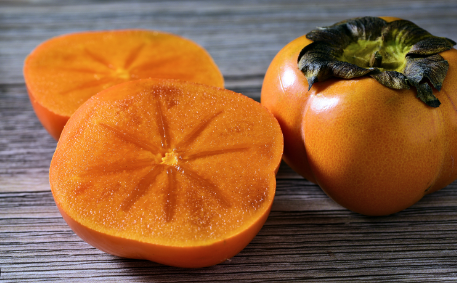
Despite the name suggesting a unique variety, it’s essentially a persimmon of the Diospyros kaki species, often closely related to or identical to the Fuyu in characteristics. It is a non-astringent persimmon similar to the Fuyu.
It’s orange, with a shape that can range from flat-round to slightly elongated, but generally tomato-like in form. Like other persimmons, Sharon Fruit is high in vitamins A and C, fiber, and antioxidants. It’s also a good source of manganese and provides a decent amount of other vitamins and minerals.
The Sharon Fruit is named after the Sharon plain in Israel (the Ha-Sharon), an 89-kilometer stretch of land situated between the Mediterranean Sea and the Samarian Hills and bordered by Nahal Taninim in the north and Tel Aviv in the south. Within this region, Sharon fruits are cultivated in the river valley and are sold domestically and exported worldwide as a premium persimmon.
Like the Fuyu, Sharon Fruit is sweet and can be eaten while still firm, which means it doesn’t have the astringency found in other persimmons like Hachiya when unripe. It has a crisp texture when fresh, similar to an apple. A distinct feature of Sharon fruits is their seedless and coreless nature. Occasionally, tiny brown specs may appear within the flesh, but this is a natural indicator of sugar and is not a sign of decay. Sharon fruits contain high sugar levels
Sharon fruits are harvested in Israel from October through February and are exported to markets worldwide. These fruits are also grown in regions with suitable climates, not just in Israel. They are cultivated in places like Spain, Italy, in regions of the Southern Hemisphere and other countries with Mediterranean climates.
The name “Sharon Fruit” was adopted for marketing to make the fruit more appealing and recognizable in supermarkets, especially in Europe. This branding helps consumers identify it as a sweet, non-astringent persimmon that can be eaten immediately without the need for ripening to remove astringency.
Sharon fruits pair well with spices such as allspice, ginger, nutmeg, cinnamon, and cloves, fruits including pears, figs, and apples, cheeses such as goat, parmesan, cottage, and manchego, and herbs including basil, mint, and thyme. Firm Sharon fruits will continue to soften at room temperature and will take about one week to transition from firm to jelly-like. Once soft, Sharon fruits can also be stored in the refrigerator for 1 to 3 days.
Characteristics and facts of Sharon Fruit
- Appearance: Has a bright orange, smooth skin when ripe. It’s typically round and somewhat flat, similar in shape to a tomato, but can vary slightly depending on the specific variety.
- Taste and Texture: It is sweet, often described as having hints of honey or even a mild, sweet spice reminiscent of cinnamon or nutmeg when ripe. Its texture when firm is crisp, much like an apple, but as it ripens, it becomes softer, offering a more custard-like consistency.
- Usage: Can be eaten fresh, sliced in salads, or used in cooking and baking. Its sweetness makes it suitable for desserts like puddings, tarts, or even as a topping for yogurt and ice cream. When very ripe, it can be pureed and used in smoothies or as a natural sweetener in recipes.
- Ripening: Unlike some other persimmons, it can be eaten while still firm, but it will soften over time. To ripen, leave it at room temperature. The ripening process can be hastened by placing it in a paper bag with an apple or banana, which emit ethylene gas, aiding in ripening.
- Nutritional Value: It is nutritious, being rich in vitamins A and C, and containing good amounts of fiber. It also provides antioxidants, manganese, and other vitamins like B6. Its high antioxidant content contributes to heart health, reduces inflammation, and supports immune function.
- Cultivation: Originally from Israel, where it was developed in the Sharon plain, this fruit is now grown in various regions with a suitable climate, including parts of Europe, Asia, and the Americas. It prefers a mild climate with some chill hours but is sensitive to very cold winters. The tree itself is quite ornamental, with beautiful fall colors.
- Harvest Season: It is harvested in the fall, from October through December, though this can vary by region based on climate conditions.
- Storage: It can be stored at room temperature if you’re waiting for it to ripen. Once ripe, it’s best kept in the refrigerator where it can last for several weeks. If you need to store it longer, you can freeze the pulp or dry the fruit.